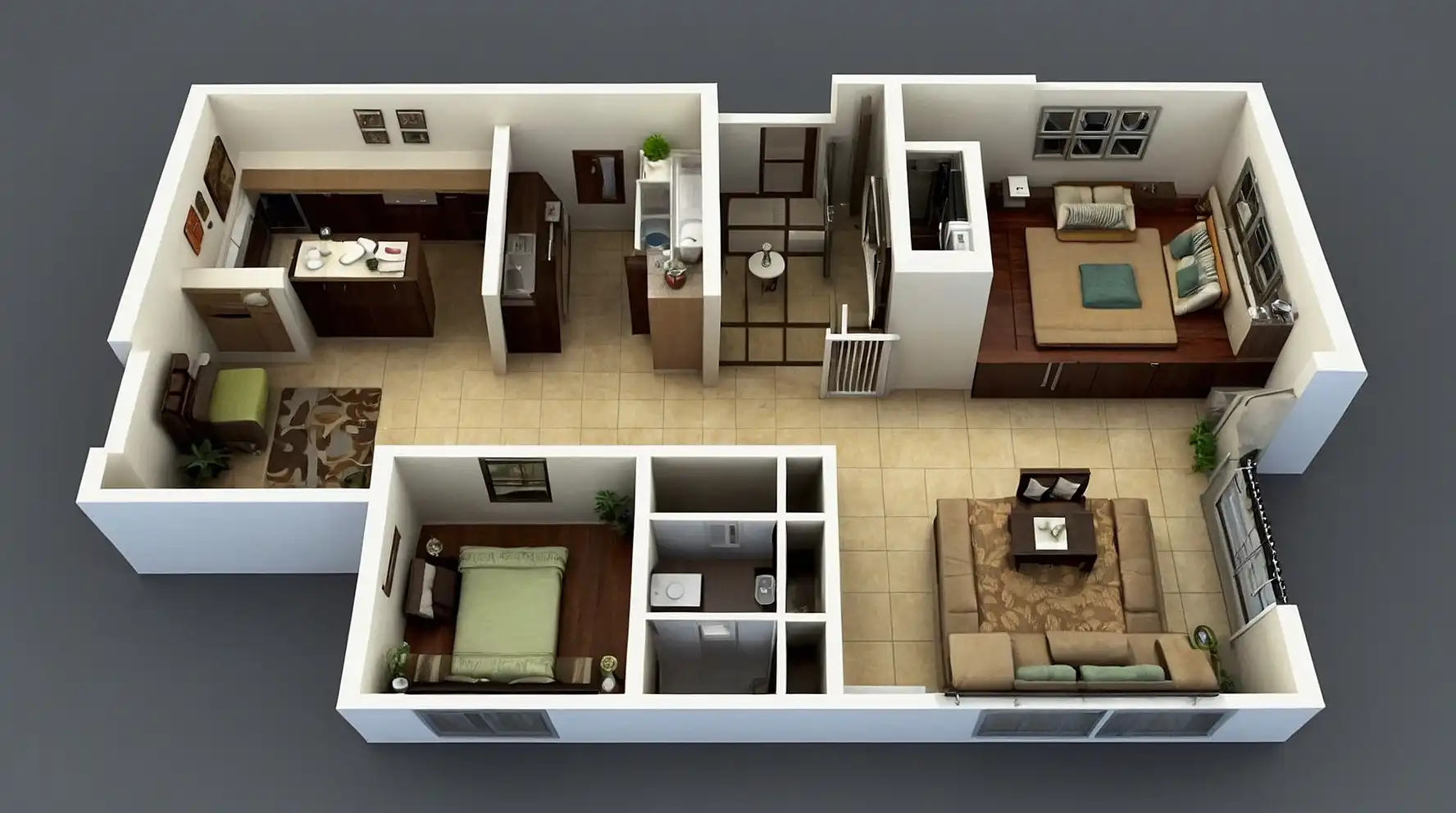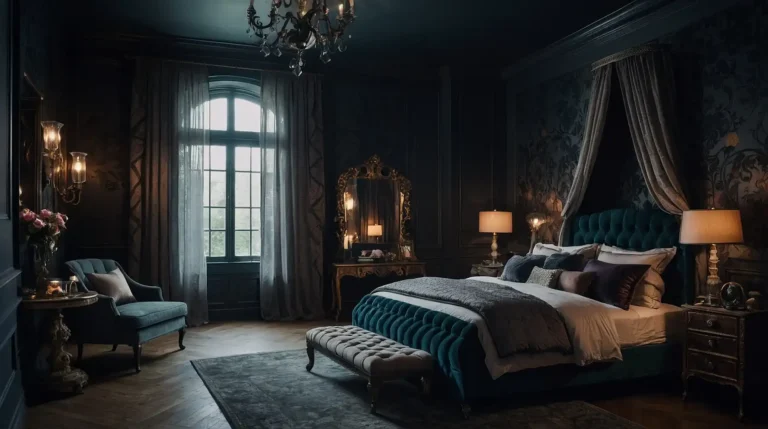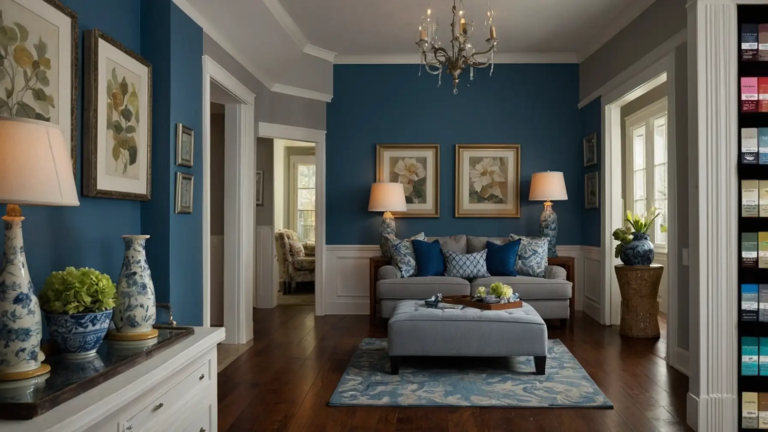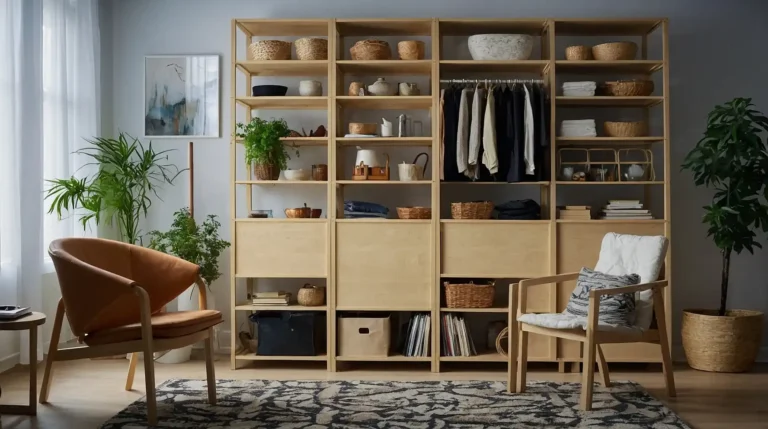27 Genius Studio Apartment Layout Ideas to Maximize Your Small Space
Studio apartment living offers freedom and simplicity, but arranging furniture in one open space presents unique challenges.
With thoughtful planning, you can create distinct zones that function independently while maintaining visual harmony.
The key lies in selecting appropriate furniture scale, utilizing vertical space effectively, and incorporating multifunctional pieces.
Strategic placement transforms a single room into a versatile home with designated areas for sleeping, working, and entertaining.
Ready to maximize your compact living situation?
These 27 clever layout ideas will help you transform your studio apartment into an organized, stylish sanctuary that feels surprisingly spacious.
1: L-Shaped Living Arrangement

Position your sofa and bed in an L-configuration against adjacent walls.
This creates a natural division between sleeping and lounging areas without physical barriers.
Add an area rug under the sofa to visually define the living space.
The perpendicular arrangement establishes distinct zones while maintaining an open feel.
This practical layout works particularly well in square-shaped studios, allowing you to face furniture toward a single entertainment center.
2: Central Room Divider

Place a substantial bookcase or shelving unit perpendicular to your walls, creating a partial wall that separates your sleeping area from living space.
Position the unit so it provides storage accessibility from both sides.
Choose an open-backed design to maintain light flow throughout your apartment.
This versatile solution creates privacy while providing valuable storage without permanently altering your space—perfect for renters.
3: Elevated Sleeping Platform

Construct or purchase a raised platform for your mattress, creating literal elevation between your sleeping and living zones.
Incorporate drawers or pull-out storage within the platform base to maximize functionality. The height difference naturally designates your bed as a separate space.
This dramatic solution works especially well in apartments with higher ceilings, creating a distinctive sleeping area that doesn’t consume valuable floor space.
4: Window-Facing Desk Positioning

Place your desk directly in front of a window to create a dedicated workspace bathed in natural light.
This positioning maximizes daylight for productivity while saving artificial lighting costs.
Keep the desk surface minimal and clutter-free to maintain the open feel.
Mount floating shelves above for additional storage without consuming floor space.
This arrangement takes advantage of often underutilized window wall space while creating an inspiring work environment with energizing natural light.
5: Corner Bed Placement

Tuck your bed into a corner, positioning it lengthwise against two walls. This arrangement minimizes the bed’s footprint in your overall layout.
Add a slim headboard or wall-mounted cushions for comfort without bulk.
The corner placement leaves central floor space open for living and entertaining functions.
This space-efficient solution creates a cozy, nest-like sleeping area while maximizing available floor space for other activities.
6: Circular Conversation Area

Arrange a small sofa and chair in a circular configuration around a coffee table near the center of your studio. This creates a defined social zone separate from utility areas.
Choose furniture with exposed legs to maintain visual lightness.
The circular arrangement facilitates conversation while creating a natural traffic pattern around the grouping.
This classic layout establishes a welcoming gathering space that functions as the heart of your studio apartment.
7: Murphy Bed Integration

Install a wall bed that folds away when not in use, instantly transforming your sleeping area into open floor space during the day.
Choose a model with integrated shelving or a desk that remains accessible when the bed is closed.
This multifunctional approach maximizes your limited square footage.
This transformative solution offers the ultimate flexibility, allowing your studio to function as a larger living room, home office, or exercise space during waking hours.
8: Sofa-Facing Kitchen Arrangement

Position your sofa to face your kitchen area, using the back of the sofa as a room divider.
This creates a natural boundary while maintaining conversation flow during meal preparation.
Add a narrow console table behind the sofa to function as additional kitchen counter space or dining surface.
The dual-facing arrangement maximizes functionality in both zones.
This practical layout acknowledges the reality of open-plan living while creating subtle division between cooking and relaxing areas.
9: Window-Adjacent Dining Nook

Create a compact dining area directly next to a window, taking advantage of natural light for meals and work sessions.
This positioning makes even small dining spaces feel more spacious.
Choose a round table to facilitate movement in tight quarters. The curved edges prevent awkward bumping in high-traffic areas.
This strategic placement transforms a potentially awkward window area into a purposeful dining space with pleasant natural illumination.
10: Wall-Length Desk/Dining Combo

Install a wall-mounted counter-height surface that serves as both workspace and dining table.
This multifunctional approach eliminates the need for separate furniture pieces.
Add adjustable-height stools that tuck completely under when not in use.
The streamlined design maintains open floor space during non-eating, non-working hours.
This space-saving solution provides dedicated surfaces for important daily activities without permanently committing floor space to single-purpose furniture.
11: Floating Furniture Arrangement

Position your key furniture pieces (sofa, bed, tables) away from walls, floating in designated zones.
This counter-intuitive approach actually creates the illusion of more space.
Place area rugs under each floating grouping to visually anchor the arrangements.
The breathing room around furniture pieces makes the studio feel more spacious and intentionally designed.
This sophisticated layout technique breaks the common habit of pushing furniture against walls, resulting in more nuanced, functional living zones.
12: Studio “Hallway” Creation

Arrange furniture to establish a clear pathway from your entrance through the apartment.
This defined circulation space helps organize distinct functional areas.
Position larger pieces perpendicular to this pathway to create natural room divisions. The intentional traffic pattern improves flow and functionality.
This organizational approach brings logic to your layout while preventing that cramped feeling that occurs when furniture placement blocks natural movement.
13: Curtained Bed Enclosure

Hang ceiling-mounted curtain tracks to surround your bed area.
This provides the ability to close off your sleeping space when desired without permanent walls.
Choose light-filtering fabrics that maintain brightness while providing privacy.
The soft vertical element adds texture while creating flexible boundaries.
This adaptable solution offers privacy when needed and openness when preferred, providing the psychological comfort of a separate bedroom without structural changes.
14: Entertainment Wall Focus

Create a comprehensive media wall that combines TV placement, storage, and display space.
This single-wall focus prevents electronics from dominating multiple areas.
Incorporate closed storage below for items you don’t want visible. The consolidated approach minimizes visual clutter while maximizing functionality.
This efficient arrangement dedicates just one wall to entertainment needs, freeing the rest of your studio for other important functions.
15: Kitchen Island Workspace

Replace a traditional desk with counter-height seating at your kitchen island or peninsula.
This dual-purpose surface serves meal prep and work needs without additional furniture.
Add electrical outlets and task lighting to support laptop work. The standing-height option provides ergonomic benefits while encouraging activity throughout your day.
This integrated approach eliminates the need for a separate desk area, conserving valuable floor space in your compact layout.
16: Corner Sectional Maximization

Choose a small-scale corner sectional sofa instead of a standard sofa to maximize seating without consuming excessive floor space.
The L-shape naturally defines your living area.
Position with the chaise extending toward the center of the room rather than along walls. This creates a natural division while maintaining openness.
This strategic furniture choice provides abundant seating in a compact footprint, making your studio more accommodating for entertaining.
17: Vertical Zone Separation

Use tall bookshelves, plants, or decorative screens to create vertical divisions between functional areas. These elements establish boundaries without solid walls.
Position dividers to maintain sight lines across your studio at eye level. The partial separation provides psychological division while preserving the open feeling.
This versatile approach allows for adjustable boundaries that can be reconfigured as your needs change throughout your tenancy.
18: Bar-Height Boundary Table

Place a narrow bar-height table between your living and sleeping areas. This creates a useful surface while establishing a visual boundary between zones.
Add stools that tuck completely underneath to maximize clearance space. The elevated height naturally divides the space without blocking light or views.
This multifunctional boundary provides a dining spot, workspace, or serving area while subtly defining your studio’s different functional zones.
19: Daybed As Room Divider

Position a daybed perpendicular to your walls to serve as both seating and sleeping space while dividing different functional areas.
This dual-purpose piece eliminates the need for a separate bed and sofa.
Add bolster pillows to create sofa-like comfort during the day. The transformative piece adapts to your needs throughout the day and night.
This space-efficient solution perfectly addresses the two largest furniture needs in a studio while creating natural room division.
20: Wall-Mounted TV Placement

Mount your television on a swivel bracket that allows viewing from multiple areas.
This eliminates the need to arrange all furniture around a single fixed viewing position.
Position at the optimal height for both seated and in-bed viewing.
The flexible mounting allows your studio to feel like it has multiple rooms, each with entertainment access.
This adaptable solution prevents your layout from being dominated by screen placement while improving functionality throughout your space.
21: Dual-Purpose Entry Console

Place a narrow console table near your entrance to serve as both landing zone and dining/work surface when needed.
Top with adjustable-height lighting for different functions.
Add seating that completely tucks underneath when not in use. The multifunctional approach maximizes utility in your entry area.
This flexible arrangement transforms typically single-purpose entry space into a hardworking zone that adapts to various needs throughout the day.
22: Built-In Bench Seating

Incorporate a window-facing built-in bench that doubles as seating and storage.
This space-efficient element takes advantage of often underutilized wall space.
Add a cushion and pillows for comfort during reading or relaxing. The hinged-top design conceals significant storage capacity for items used less frequently.
This dual-function feature adds architectural interest while providing both practical seating and hidden storage in minimal square footage.
23: Breakfast Bar Room Division

Use a counter-height table or breakfast bar to separate your kitchen from living areas. This creates a natural boundary while providing dining and work surface.
Choose backless stools that slide completely under when not in use. The open clearance maintains traffic flow while maximizing functionality.
This practical divider acknowledges the need for separation while embracing the open-concept reality of studio living.
24: Symmetrical Layout Balance

Arrange your studio with matching elements on opposite walls for visual balance. This creates a sense of intentional design rather than haphazard furniture placement.
Position your bed and sofa on opposing walls with similarly scaled side tables. The mirrored arrangement creates harmony in an otherwise eclectic space.
This designer approach brings sophistication to your layout while making the space feel more intentionally planned rather than constrained.
25: Nested Table Arrangement

Incorporate a set of nesting tables that can be expanded when entertaining or contracted when space is needed.
This adaptable solution provides surfaces only when required.
Choose styles with slim profiles and visible legs for visual lightness. The variable configuration adapts to changing needs without permanent space commitment.
This flexible approach acknowledges the reality of fluctuating space requirements in studio living while maintaining design consistency.
26: Floor Pillow Conversation Zone

Create a casual seating area using floor pillows or poufs around a low coffee table. This alternative to traditional sofa seating can be easily rearranged or stored.
Choose washable covers and substantial filling for comfort and durability. The low-profile arrangement maintains open sight lines throughout your studio.
This adaptable approach works particularly well for younger residents or those who entertain casually, providing seating that doesn’t permanently occupy valuable floor space.
27: Mirrored Wall Expansion

Install a large mirror on one strategic wall to visually double your perceived space.
This classic designer trick creates the illusion of spaciousness without structural changes.
Position to reflect your most attractive features or natural light sources. The reflective surface bounces light throughout your studio, enhancing brightness.
This visual expansion technique dramatically transforms how your space feels without changing the actual square footage or furniture arrangement.
Conclusion
Transform your studio from a single room into a multifunctional home by implementing these strategic layout ideas.
Start with defining your essential zones, then choose furniture and divisions that support both your lifestyle and the architectural realities of your space.







